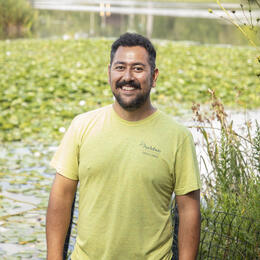Earlier this month, I joined the Chicago Wilderness Alliance’s Celebration of Conservation event at the Morton Arboretum, as the Calumet Land Conservation Partnership (CLCP) was presented with a Force of Nature Award.
Audubon Great Lakes is one of eleven partner organizations that comprise the CLCP. For more than five years, the CLCP has banded together to protect nature across the Calumet region of Indiana and Illinois, expanding wetlands restoration and increasing opportunities for local communities to engage with the outdoors through recreation and stewardship.
Presented by the Chicago Wilderness Alliance, The George B. Rabb Force of Nature Award celebrates people and organizations whose conservation, restoration, advocacy and educational activities are inspirational examples for others. The CLCP was recognized for its Conservation Action Planning in the Calumet Region project, which is a bold collaborative approach to protecting nature and improving communities in the bi-state region.
Protecting the Calumet Region
I can attest to the power of this collaboration and partnership. It’s been incredible to see conservation and community stakeholders come together to care for these special natural areas. And the Calumet region is a very special place.
Spanning from northwest Indiana to southeast Chicagoland, the region once consisted of nearly 45,000 acres of marsh and wet prairie. As development began to dominate the region, marsh bird populations were decimated. Despite this massive land conversion, the patchwork of marshes that remained still continue to support incredible biodiversity. Some of the richest natural areas in the Midwest are hidden among the Calumet region’s residential, urban, and industrial development.
The region is hugely important for secretive marsh birds, which is only backed up by our data. Audubon scientists identified the region as one of the 12 highest-priority coastal regions for 14 key species of marsh birds, water quality and coastal resiliency across the Great Lakes.
Our participation on the CLCP has allowed us to advance our work in the region to restore the critical wetland habitat birds need to thrive, including our work along the West Branch of Little Calumet River. We work with volunteer and contracted bird monitors across the region to help measure bird response to restoration, and they have observed increased use of these wetlands by species like Swamp Sparrow, Common Gallinule, Virginia Rail and Sora from 2017 to 2022. Learn more about Audubon Great Lakes’ work in this priority region.

An Action Plan for the Region
As part of the partnership, we were proud to help produce a series of coordinated Conservation Action Plans for the region that identify areas most in need of conservation, community health and well-being needs, threats, and strategies to work together and engage new partners in addressing these needs collaboratively. These action plans were included in a report released by the CLCP last year, “Conservation Action Planning in the Calumet Region.”
Covering nine focus areas, the integrated Conservation Action Plan acts as a blueprint that will help guide conservation partners, stakeholders and community members to identify commonalities across the region in order to coordinate effort and resources, share best practices, and identify next steps for conservation, engagement, and fundraising. Moving forward, the CLCP will work to incorporate community needs and plans within the Action Plan.
Hear from some of the CLCP partners on the power of this collaboration:
- “I am thrilled the work of the CLCP was recognized with a Force of Nature Award. All conservation partners know that we can’t succeed without broad community engagement and support. The impressive scope of this report exemplifies the power of partnership work across the region. Partners representing diverse perspectives are able to make tremendous progress when working in collaboration toward shared conservation goals.” - Victoria Wittig, Ambassador for the Northwest Indiana Urban Waters Federal Partnership
- “Our work is never done, and this initiative will continue to evolve as we expand our engagement across diverse communities, grow and learn from one another, and ultimately become stronger stewards, together. We’re excited for the next iteration of the CAP process, engaging with municipalities and incorporating community feedback in our planning and work.” - Katie Hobgood, Program Director for Save the Dunes
CLCP partners include Audubon Great Lakes, Save the Dunes, Shirley Heinze Land Trust, The Nature Conservancy, Northwestern Indiana Regional Planning Commission, National Parks Conservation Association, Openlands, Metropolitan Planning Council, The Wetlands Initiative, The Field Museum and the Northwest Indiana Urban Waters Federal Partnership.








